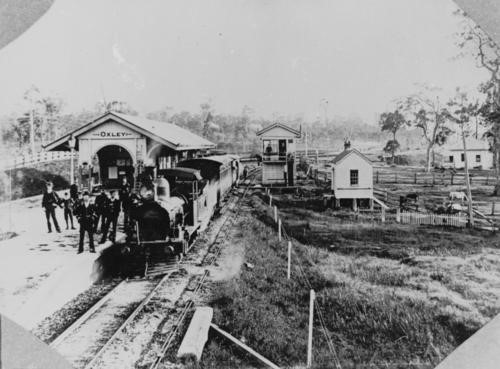Addresses
Type of place
Railway station
Period
Victorian 1860-1890
Style
Arts and Crafts
Addresses
Type of place
Railway station
Period
Victorian 1860-1890
Style
Arts and Crafts
Oxley Railway Station was first opened in 1874 as the line from Ipswich to Sherwood was completed. In 1886 a brick passenger station was built. This building is the oldest surviving example of an island platform brick station building on the Brisbane railway system and as such is rare. The Oxley Railway Station is an important reminder of the progress of Brisbane’s outer suburbs due to the coming of the railway.
Lot plan
L151_SP230852
Key dates
Local Heritage Place Since —
Date of Citation —
Construction
Walls: MasonryCriterion for listing
(A) Historical; (B) Rarity; (D) Representative; (E) AestheticInteractive mapping
Lot plan
L151_SP230852
Key dates
Local Heritage Place Since —
Date of Citation —
Construction
Walls: MasonryCriterion for listing
(A) Historical; (B) Rarity; (D) Representative; (E) AestheticInteractive mapping
History
A major factor in the development of Oxley was the completion of the Ipswich to Brisbane railway line in 1876 that provided a direct rail link between the towns. Prior to this the Ipswich line reached Sherwood and passed through Oxley from 1874. This reduced the isolation of the area and allowed for increased subdivision. The move to the Oxley and Darra areas, however, was gradual and the rural feel was retained for some time.
By the late nineteenth century Oxley had two main areas of development. The first was along Ipswich Road where the hotel had been established. Businesses such as a store, a butcher and a blacksmith shop were established as the population slowly increased and the need for services arose. In 1864 a non-denominational church was built near the corner of Bannerman and Ipswich Roads and the first Oxley school was built in 1873 with 32 enrolments when opened. This area became known as Oxley Central. The second area of development in Oxley was beside the railway station. However, this was slower to develop commercially than the first.
Initially the Ipswich line had only one track that ran exclusively between Ipswich and Brisbane. But the demand for more efficient and more frequent train services increased due to several factors including population growth in the outer Brisbane suburbs. In 1886-87 the Brisbane to Ipswich line was duplicated, creating an island between the two tracks at Oxley Station. As a result of the new island a new station building was deemed necessary that would give the stationmaster improved control over both platforms. In 1886 a new brick station building was constructed and was built under the design specifications of the Queensland Railway Department. Within the newly built brick station there was a ticket office, a waiting area, a ladies room and closet, a store and a telegraph office. Only Toowong Station shared the same design as Oxley, however, this station has been demolished. Access to the station island was from two concrete subways, also built in 1886.
As well as serving the Oxley residential population, the Oxley Station provided a means of transportation into and out of the industries in the area. Several separate sidings were built at the station. One of the major industries at Oxley was the Foggitt-Jones bacon factory. Beside the station were several large holding paddocks for pigs that were then transported to the nearby factory situated along Oxley Creek. This was an important facility for the factory as it kept the cost of livestock transportation at a minimum. The siding was in use well into the 1960s. Another siding was used by Brittain’s Brickworks. The successful brick-making industry, situated between Oxley and Darra utilised the railway as a means of transporting their stock out of the factory site, this too, serviced the site into the 1960s.
Other structures that were built on the station but no longer exist were an engine turntable with an interlocked cabin and cream sheds.
In the post-war period the Ipswich line was quadrupled from Chelmer to Corinda resulting in the original station buildings being demolished and replaced. However, the expansion of the line did not go as far as Oxley, thus the original nineteenth-century station remains. The significance of the Oxley station is acknowledged in the Queensland Rail Heritage Study (2002) that states “Oxley Station is significant as the oldest surviving island platform brick station building on the Brisbane suburban system”. The station is important as a rare example of a nineteenth-century brick station building in Brisbane and is a reflection of the area’s suburban settlement as a result of the expansion of the Ipswich line.
Statement of significance
Relevant assessment criteria
This is a place of local heritage significance and meets one or more of the local heritage criteria under the Heritage planning scheme policy of the Brisbane City Plan 2014. It is significant because:
References
-
Fones, Ralph, Oxley! A Mind of its Own, Oxley-Chelmer History Group, 2006
-
Grantham, Lona, Heritage Tour: An Historical Tour of Oxley, Oxley-Chelmer Historical Group, 2003
-
Judy Gale Rechner, Brisbane House Styles 1880 to 1940: a guide to the affordable house, Brisbane: Brisbane History Group Studies No. 2, 1998
-
Historic Titles, Department of Environment and Resource Management
-
John Kerr, “The Evolving Railways of Brisbane”, Public, Practical, Personal, Brisbane History Group Papers, 1981
-
John Kerr, “Gaythorne Station”, Queensland Rail Heritage Report, 1993
-
A Heritage Management Survey for Queensland Railways, Metropolitan South Part 1, Bruce Buchanan Architects, 2002
Citation prepared by — Brisbane City Council (page revised June 2022)


